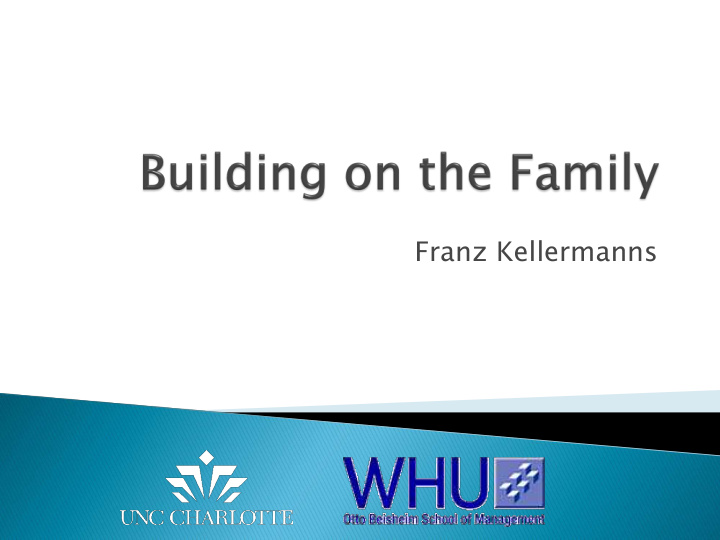



Franz Kellermanns
Importance of “family friendly” journals ◦ Family Business Review (Impact Factor 4.42) ◦ Journal of Family Business Strategy (will receive Impact Factor) ◦ Entrepreneurship Theory and Practice ◦ “Main stream journals” ,e.g., Journal of Management Studies
Topic Areas in Family Business Research Current Chrisman et Study al., 2003 Strategic Management Topic Classification (n=291) (n=190) Δ % * No. % No. % 1.1 Economic Goals 5 1.7% 5 2.6% -33.8% Goals and 1.2 Non-Economic Goals 3 1.0% 5 2.6% -60.4% Objectives 1.3 Goal Formulation Process 0 0.0% 1 0.5% -100.0% 2.1 Strategic Planning 9 3.1% 6 3.2% -3.4% 2.2 Resources and Competitive Advantage 25 8.6% 11 5.8% 48.1% 2.3 Environment Opportunity and Threats 4 1.4% 4 2.1% -34.8% 2.4 Corporate Strategy 4 1.4% 3 1.6% -14.4% Strategy Formulation 2.5 Business Strategy 5 1.7% 2 1.1% 56.4% and Content 2.6 Functional Strategy 6 2.1% 7 3.7% -44.3% 2.7 International Strategy 6 2.1% 6 3.2% -35.6% 2.8 Entrepreneurship and Innovation 15 5.2% 10 5.3% -2.8% 2.9 Stakeholders, Ethics, Social Responsibility 8 2.8% 4 2.1% 31.0% 3.1 Corporate Governance 56 19.2% 18 9.5% 102.5% 3.2 Structure 12 4.1% 3 1.6% 157.5% Strategy 3.3 Systems, Processes, and Networks 8 2.8% 5 2.6% 5.8% Implementation 3.4 Behaviors and Conflict 19 6.5% 12 6.3% 3.7% and Control 3.5 Culture and Values 13 4.5% 9 4.7% -4.9% 3.6 Evolution and Change 15 5.2% 3 1.6% 221.9% 4.1 Leadership and Ownership 46 15.8% 14 7.4% 113.6% Management 4.2 Professionalization 8 2.8% 4 2.1% 31.0% 4.3 Succession 44 15.1% 42 22.1% -31.6% Other 5 Other Topics Relevant to Strategic Mgt 34 11.7% 19 10.0% 16.8% Non-Strategy 6 Non-Strategic Mgt Topics 28 9.6% 43 22.6% -57.4%
Given that research has viewed the family as both a hindrance and help to the family firm, researchers that considers business outcomes a function of family and business characteristics is important.
The components of involvement approach considers the family’s involvement in ownership, management or control (Chrisman et al., 2005). It is the basic necessary condition for a family to exercise influence on the family firm and sets the minimum threshold for considering a firm a family firm. The essence approach argues that “ family involvement must be focused and directed toward behaviors that produce distinctiveness before the firm can be classified a family firm ” (Pearson et al., 2008: 966)
Does family involvement bring advantage to family firms ’? Positive View Negative View ◦ the problems of close ◦ the confluence of kinship, ownership and family and businesses management transfers, systems could lead to and conflicting “familiness” that make intentions may create business peculiarly inefficiencies suited to survive and grow
Over-simplification in the operationalization of family involvement ◦ Researchers have largely focused on family ownership ◦ Yet, family involvement is in fact multi-dimensional Overlook of curvilinear relationships Overlook of a contingency view ◦ the impact of a given firm involvement factor may depend on the interaction process among top managers and family members ◦ this process could influence a firm’s capability to exploit the upside of the family involvement factor and minimize the downsize of it
Organizational Identity Components Essence Approach Approach Zellweger, Eddelston, Kellermanns (2010)
Amongst Others: Financial Performance Socio-emotional Wealth Succession Corporate Entrepreneurship Strategic Flexibility
Constructive confrontation creates a culture where decision-making and problem solving are based on substantive argument rather than hierarchy, power, or personality. Constructive confrontation occurs when teams are able to define conflicts in terms of a mutual problem, requiring collaborative efforts, rather than one of competing interests. ◦ Negative conflict (relationship conflict) is avoided ◦ Positive conflict (cognitive conflict, process conflict) is encouraged
Stewardship Culture: Altruism towards family and the firm Sound Family Relationships Long-term orientation Contingencies: Stage of Organizational Development Identification with the family business Desire for transgenerational sustainability Justice Perceptions (both family and non-family members)
Socio-emotional wealth (SEW) captures non-economic utility of organizational ownership (see e.g. Gomez-Mejia et al., 2007) Socioemotional benefits are e.g. the creation of a positive family image / reputation, preserving the family tradition, the creation of personal prestige etc.
€ Total Firm Value Emotional Value Financial Value, Incl. financial private benefits of control Zellweger, 2006; Zellweger & Astrachan, 2008; Astrachan & Jaskiewicz, 2008
Need a Theory of SEW 1. Theory of SEW must contain social and emotional influences. Emotions aspects widely unexplored. 2. Complete theory of SEW must consider both positively and negatively valenced socioemotional aspects. So far, focus on positively valenced factors. 3. SEW can help regional development and internationalization decision.
Non-economic goals Intermediate goals: ◦ Flexibility ◦ Ambidexterity ◦ Corporate Entrepreneurship ◦ Internationalization Processes Enable: ◦ Financial Performance Help in achieving: ◦ Succession/Ownership Transfer/Dynasty Building
Remarks focused on family members, we need to broaden our view to include non-family members. What is the role of family and non- family members in the internationalization process in relation to SWE? Can SEW be “bend” by external pressures? Local SEW focus can explain investment and expansion decisions. Placement of family members in foreign subsidiaries could be driven by SEW concerns. Focus on family members needs reduces internatinalization (Debicki, 2012), more research needed.
Family configurations need to be explored Family firm specific characteristics as antecedents or contingencies ◦ Components Approach ◦ Essence Approach ◦ Identification Family Ownership Generational Ownership Dispersion Family Management Generations involved in management Family Board Membership Generations involved on board Transgenerational sustainability desires
Recommend
More recommend